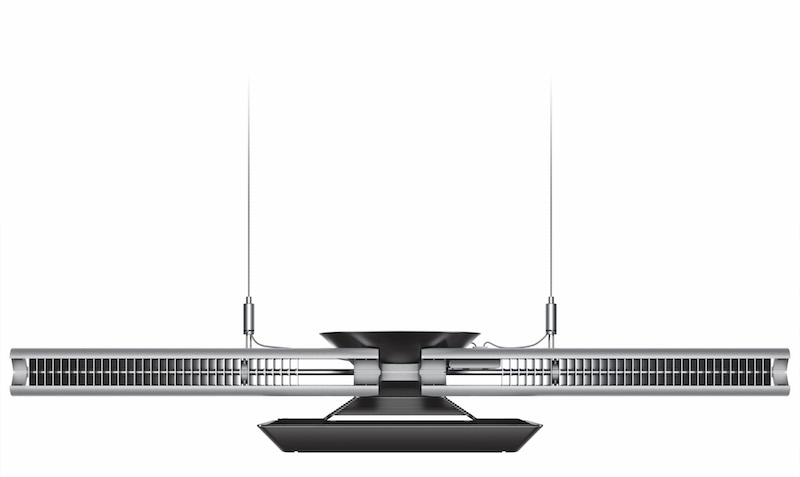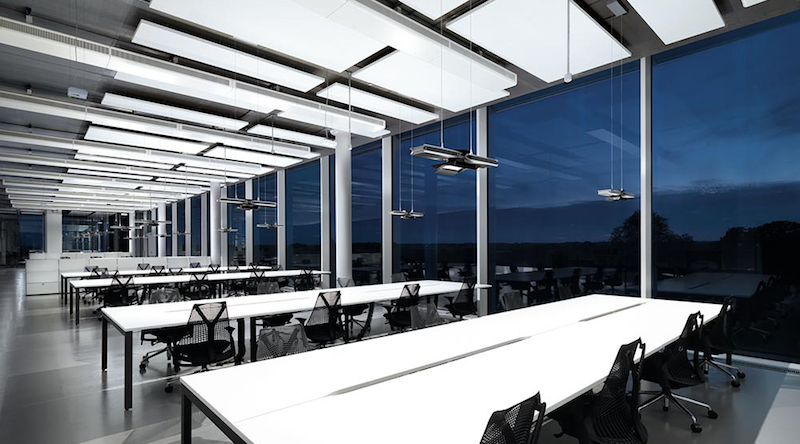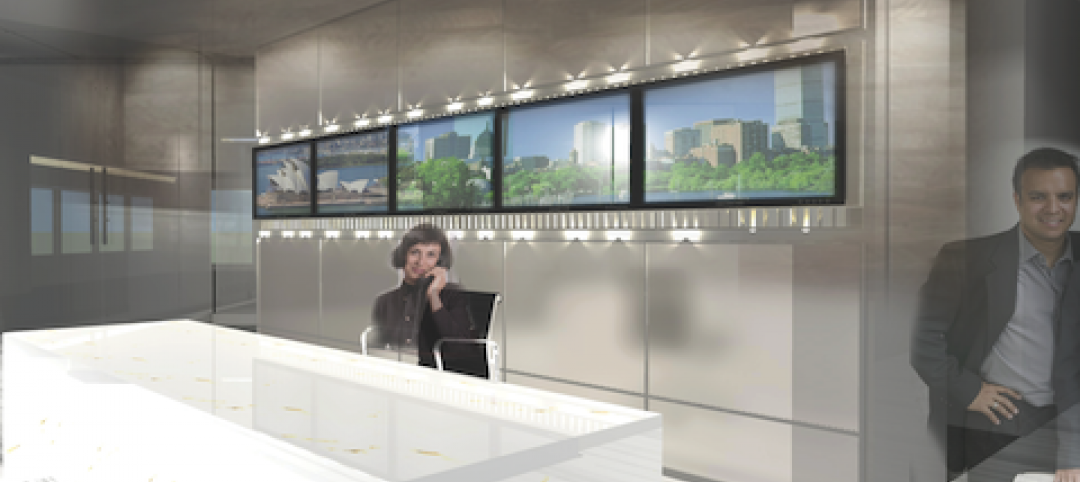Dyson is mostly known for its (expensive) vacuum cleaners that claim to never lose suction and have the ability to get every inch of your carpet clean, but Dyson’s newest invention isn’t a new super powerful or ultra quiet vacuum cleaner, in fact, it isn’t a vacuum cleaner at all; it’s the Cu-Beam Duo, a light that is rated to operate for 22 years without a bulb change.
As Fastcodesign.com reports, the Cu-Beam Duo is a new lighting system that uses just two LEDs, not the hundreds that most commercial lighting fixtures use, to light the space below the fixture, above the fixture, or a combination of the two. Each LED is about the size of a quarter, massive for LED standards, and is fitted with custom-engineered lenses to spread the glow over a larger area. One LED provides the light for task surfaces below while the other provides the ceiling light, which is optimal for illuminating open spaces like atriums, or offices.
The actual lights make up just a small portion of the 28-inch fixture, however. The rest is a large heat sink with the sole purpose of keeping the LEDs cool because a cool LED can run for a very long time without fading or discoloring. The Cu-Beam Duo uses heat pipe technology to cool the two LEDs.

The Cu-Beam Duo uses six vacuum-sealed heat pipes to transfer heat away from the light source to be dissipated along the wings. Each tube contains a drop of water. When the light is turned on, the heat turns the water into vapor. The vapor then disperses throughout the pipe and, when it reaches a cool area of the tube, condenses back into water. A copper wick then draws the water back toward the heat source and the process starts again.
The idea to cool LEDs with a heat pipe was first used in the CSYS desk lamp, a lamp that came with the promise of running for 40 or 50 years without needing to change the bulb. The Cu-Beam Duo takes this initial technology and improves and expands upon it.
The stock light puts out 8,500 lumens but it can be changed and fitted with a 20,000 lumen LED. Additionally, there are sensors that can detect when no one is at the table or workspace below and shut off the down light, leaving just the up beam on to keep the room illuminated. Additionally, the each lamp has internal shutters that can crop the down beam to the width of the table below with no spill. The crop light is not wasted, though. The Cu-Beam Duo uses "Ricochet" technology to convert any unwanted down light into up light.
The Cu-Beam Duo has not been priced yet, but the company says it was designed with the intention of being used for large-scale, commercial products. The lights will be available in silver, black, and white with Dyson offering a range of custom colors, as well.
Related Stories
| Jan 21, 2011
Sustainable history center exhibits Fort Ticonderoga’s storied past
Fort Ticonderoga, in Ticonderoga, N.Y., along Lake Champlain, dates to 1755 and was the site of battles in the French and Indian War and the American Revolution. The new $20.8 million, 15,000-sf Deborah Clarke Mars Education Center pays homage to the French magasin du Roi (the King’s warehouse) at the fort.
| Dec 17, 2010
New engineering building goes for net-zero energy
A new $90 million, 250,000-sf classroom and laboratory facility with a 450-seat auditorium for the College of Electrical and Computer Engineering at the University of Illinois at Urbana/Champaign is aiming for LEED Platinum.
| Nov 3, 2010
First of three green labs opens at Iowa State University
Designed by ZGF Architects, in association with OPN Architects, the Biorenewable Research Laboratory on the Ames campus of Iowa State University is the first of three projects completed as part of the school’s Biorenewables Complex. The 71,800-sf LEED Gold project is one of three wings that will make up the 210,000-sf complex.
| Nov 3, 2010
Park’s green education center a lesson in sustainability
The new Cantigny Outdoor Education Center, located within the 500-acre Cantigny Park in Wheaton, Ill., earned LEED Silver. Designed by DLA Architects, the 3,100-sf multipurpose center will serve patrons of the park’s golf courses, museums, and display garden, one of the largest such gardens in the Midwest.
| Nov 3, 2010
Senior housing will be affordable, sustainable
Horizons at Morgan Hill, a 49-unit affordable senior housing community in Morgan Hill, Calif., was designed by KTGY Group and developed by Urban Housing Communities. The $21.2 million, three-story building will offer 36 one-bed/bath units (773 sf) and 13 two-bed/bath units (1,025 sf) on a 2.6-acre site.
| Nov 3, 2010
Virginia biofuel research center moving along
The Sustainable Energy Technology Center has broken ground in October on the Danville, Va., campus of the Institute for Advanced Learning and Research. The 25,000-sf facility will be used to develop enhanced bio-based fuels, and will house research laboratories, support labs, graduate student research space, and faculty offices. Rainwater harvesting, a vegetated roof, low-VOC and recycled materials, photovoltaic panels, high-efficiency plumbing fixtures and water-saving systems, and LED light fixtures will be deployed. Dewberry served as lead architect, with Lord Aeck & Sargent serving as laboratory designer and sustainability consultant. Perigon Engineering consulted on high-bay process labs. New Atlantic Contracting is building the facility.
| Nov 2, 2010
A Look Back at the Navy’s First LEED Gold
Building Design+Construction takes a retrospective tour of a pace-setting LEED project.
| Nov 2, 2010
Wind Power, Windy City-style
Building-integrated wind turbines lend a futuristic look to a parking structure in Chicago’s trendy River North neighborhood. Only time will tell how much power the wind devices will generate.
| Oct 13, 2010
Prefab Trailblazer
The $137 million, 12-story, 500,000-sf Miami Valley Hospital cardiac center, Dayton, Ohio, is the first major hospital project in the U.S. to have made extensive use of prefabricated components in its design and construction.
| Oct 13, 2010
HQ renovations aim for modern look
Gerner Kronick + Valcarcel Architects’ renovations to the Commonwealth Bank of Australia’s New York City headquarters will feature a reworked reception lobby with back-painted glass, silk-screened logos, and a video wall.
















